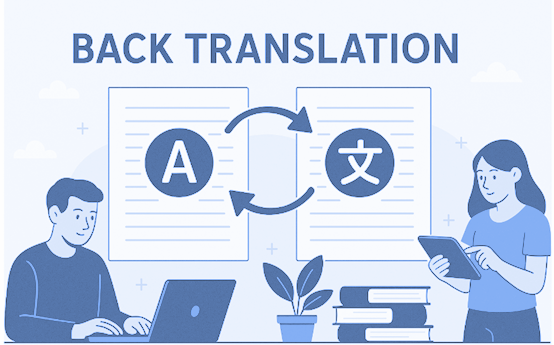Significance of Back translation in Multilingual Communication
Significance of Back translation in Multilingual Communication
Let’s cut to the chase, in today’s global marketplace, a mistranslation can cost you clients, credibility, or worse. It’s not just embarrassing. Governmental organizations, businesses, and non-profits are all competing on a global scale these days. And translations that are “good enough”? Insufficient. You’re doomed if your message doesn’t fit the context or the culture.
Back translation can help with that. Consider it your safety net. You send your translated content to a different translator, who returns it to the source language. You can then determine whether the actual meaning has been conveyed. You’re safe if it did. Otherwise, you catch those errors before they become an issue for someone else.
This article will explain what back translation is, how businesses are utilizing it, why it’s an excellent idea, and how it fits into an effective translation workflow. To be honest, it’s a sanity check that no company that values its reputation should neglect.
Understanding Back Translation
Back translation has become increasingly useful. Organizations may obtain a better understanding of the quality and accuracy of their translations by cycling content back to its original language. We’ll go into the specifics, including the benefits, the realities, and how top companies are incorporating this step into their translation workflow.

What Is Back translation?
Back translation can also be defined as reverse or backward translation which is the process of translating texts that were translating into another language(s) back to the original source language. This is usually done to check the accuracy of the first translation; think of this as a way to double-check the accuracy. Here’s an example; if you translate a file from English into French and would like to check if this matches with the English, you will have another translator translate the French back to English.
Evolution and Historical Context
The idea of back translation dates back to the early days of international diplomacy and the translation of religious texts. One early example is the Bible, where many rounds of translation and back translation were done to keep the theological meaning consistent.
Back translation really took off in the academic and clinical world once the globe started shrinking in the 20th century—thanks, globalization. Suddenly everyone’s swapping surveys and psych tests around the world, and, well, nobody wants a question about “feeling blue” to turn into “feeling like a literal blueberry” overseas. So, researchers started back-translating stuff just to double-check that the meaning wasn’t getting totally lost in translation. Honestly, it’s like an international game of telephone, but with way higher stakes.
Today, back translation has advanced with technology. AI tools like ConveyThis use automated translation and quality checks to help quickly and reliably verify content for websites, apps, and documents.
The Back Translation Method
Back translation isn’t just academic jargon, it’s a staple in business for maintaining linguistic precision. Here is how the process actually plays out in a corporate world.
1. The Initial Translation
The original content is first assigned to a professional translator, someone with real expertise in the specialized field unlike automated machine tools. The translator translates the content into the client’s requested language(s). It is important for the translation to be accurate as even the smallest mistake could change the entire intended message. That is why there’s zero tolerance for any shortcut, every detail matters to ensure the translation is accurate and results meet the client’s expectations.
2. The Back Translation
A different translator steps in, someone who hasn’t seen the original text. Their job? Bring that translated document back into the source language. No hints, no shortcuts. If the back translated version feels a bit off or inconsistent, it’s a red flag. You then spot the issues, update the translation, and make sure your business communications are bulletproof before they go public.
3. Proofreading
After the translation and back translation are ready, they are sent to a proofreader. This person is responsible for comparing both the original document and the back-translation, side by side to check for grammar mistakes, missing details and any inconsistencies. If the proofreader detects anything that may seem to be incorrect, it is noted and sent back for revisions.
4. Final Revisions before Approval
This is the final stage and tends to take some time as it involves multiple rounds of feedback and revisions. It is crucial as there is no way around it in order to provide an accurate, up-to-standard result that matches exactly what the client expects. The translation is now ready for use after the finalized version is approved by everyone involved.
Why it is Important? – Here are the Benefits of Back translation
Verifying the accuracy of translated materials requires back translation. It identifies possible errors, omissions, or cultural misinterpretation that might have occurred during the initial translation process.
Enhancing Translation Accuracy
Translation in highly regulated sectors like medicine and finance is compliance with law as well as language. Creating documents especially when dealing with confidential information like patient data or clinical trials entails compliance with local laws and regulations. Often requested in these cases, back translation—reversing a document to its native language in order to ensure its accuracy is also recommended.
Meeting Standards of Compliance
Whether it concerns acquiring approval for a medication trial or the worldwide dissemination of financial records, documentation in controlled sectors must meet demanding legal standards. Back translation is sometimes needed by regulatory agencies to guarantee that nothing is overlooked or incorrectly portrayed throughout the translation process. This technique offers an important degree of verification when clarity and compliance are top priority.
Developing Credibility among Worldwide audiences
Trust is the foundation of a good worldwide communication plan. Translation is not merely conveying in highly controlled sectors such as finance and pharma; translation also involves compliance. When documents are being put together, there is an overwhelming necessity to comply with regulations and laws locally, particularly when handling sensitive information such as patient records or clinical trials. Back translation, where one translates a document back into the original language for checks on its accuracy, is not only advisable but also in many instances obligatory.
Challenges and Limitations
Despite its utility in verifying the accuracy of translated materials, back translation presents several drawbacks and limitations. Some of the key downsides include:
- The process can take a long time and be expensive. Iterative translation back and forth tends to be a lengthy process which involves much resource. A crew of professionals consisting of translators, proof readers, who undergoes different review levels. All of that can start to add up, especially on more involved or larger projects.
- Literal interpretation issues. Back translations emphasize literal accuracy which causes many cultural nuances, idiomatic expressions, and stylistic elements from the source language to disappear. The initial translation’s quality and content often suffer degradation during back translation
- The possibility of false positives. Even very minor changes in wording that have no ultimate effect can sometimes be caught and corrected, resulting in unnecessary error correction. The misinterpretation of subjective word choices creates vexing situations where differences lead to unintended alterations and result in lost time and value.
Mitigation Strategies
In order to tackle these problems:
- Pay attention to semantic counting, rather than word-to-word mapping
- Employ proficient back translators, who are specialists in the area.
- Define specific evaluation categories to separate the critical differences from stylistic ones.
- Use project management software to improve communication and versions.
Methods to Achieve Successful Back translations
To achieve successful back translations, attention to each stage’s processes in details is required. Every phase requires a clear plan, including choosing the optimal translators and the execution of every communication process.
Choosing Skilled Translators
Select experts who possess both bilingual abilities and bicultural understanding. The optimal scenario requires translators to be native speakers of the target language for initial translation and native speakers of the source language for back translation. The necessity for subject-matter expertise reaches critical importance within technical and specialized domains.
Setting Up Clear Guidelines
Initiate the procedure by establishing distinct anticipations regarding:
- Terminology usage
- Acceptable variations
- Cultural nuances
- Formatting and structure
The presence of clear guidelines reduces potential misunderstandings while maintaining uniformity in translated texts.
Utilizing Technology and Tools
Tools such as Translation management systems, glossaries, and CAT tools streamline the back translation process by:
- Boosting consistency
- Keeping tabs on changes
- Organizing workflows
- Offering version control
Access to the right tools ensures smarter business decisions—not just improving translations. Reducing errors and eliminating inefficiencies saves valuable resources.
Back Translation Services
When you require a translation service at your organization, back translation may also be an important service to utilize in the process. Many translation service providers also have back translation services to verify meaning, cultural relevance, context appropriateness, while also checking the translations for errors.
What is required for a business to have back translation services?
- Qualified Professionals: Working with qualified translators with excellent competence of both the source and target languages is absolutely vital to guarantee correct translations.
- Back Translators: Someone who hasn’t viewed the source document to help eliminate any possible bias in the translation process.
- Quality Control Process: Without this system, it would not be possible to detect faults in relation to the back-translated document and the original text.
- Clear Communication: Effective interaction aids comprehension. In this case, it is vital pertaining to the client and translator with respect to the aim of the translation and the needs of the back translation.
Real-World Examples of Back translation
Let’s go through a few examples to analyze the concept and methodology behind back translation:
- Original (English): Time flies when you’re having fun.
Translated (Italian): Il tempo vola quando ti diverti.
Back Translated: Time flies when you are having fun.
➜ The phrase retains its original meaning and wording, showing a direct translation with cultural alignment. - Original (English): Break a leg!.
Translated (Japanese): 成功を祈るよ.
Back Translated: I wish you success.
➜ The idiom was localized for cultural understanding. The meaning is preserved, but the expression changes entirely. - Original (English): She spilled the beans!
Translated (Portuguese): Ela revelou o segredo!
Back Translated: She revealed the secret!
➜ This shows an idiom translated for clarity, maintaining the intent but altering the metaphor.
Integrating Back translation into Your Workflow
When you include back translation in your process, you can boost the precision and uniformity of your translations. This also provides an additional step to check quality.
When to Implement Back translation?
Back translation isn’t necessary for all projects. Consider implementing it when:
- Precision stands as a fundamental necessity within industries like:
- legal
- medical
- financial documentation.
- The task of translating into numerous languages demands consistent output.
- The existence of cultural and linguistic sensitivities presents intricate challenges.
- Engagement with regulatory bodies and auditors necessitates your collaboration.
Simplifying the Back Translation Process
To integrate back translation efficiently:
- Avoid last minute rush: Make certain that you do not leave back translation for the last minute. Doing so will lead to delays in the future.
- Maintain clarity for your documents: Centralize all versions, updates and comments so that the documents are consistent and easy to access.
- Use Technology: Make use of tech tools like ConveyThis. They help manage workflows, track changes, and keep terminology consistent. No need for manual headaches.
- Promote Team Coordination: All participants in the process; translators, reviewers, subject experts – must agree on the objectives, and be clear about what they are doing and when, and therefore avoid ambiguity later when expectations have not been aligned up front. When all team members’ expectations have been aligned at the beginning of the project, the flow of work is much more seamless.
Also, if you support back-translation during the first part of the process you make the quality control process much stronger. In this way, you can stay in the contracted timeline and budget with no unexpected surprises or costs. Including back-translation during the beginning of the process will also help to reinforce quality control, contract adherence, and planned timeline while avoiding scope errors or costs.
Closing Remarks
Back translation is not an unnecessary step; it is essential for achieving accurate multilingual communication. It helps avoid expensive blunders, keeps your compliance department happy, and builds international client trust. Of course, it requires a greater time and resource investment, but this is necessary in high-stake sectors like law and healthcare.
You need to know when and how to use back translation to get the most out of it. Used smartly, it’s a core part of any serious global communication strategy.
Platforms like ConveyThis make the whole process smoother, from medical paperwork to legal agreements to polished marketing materials. Back translation is another layer of your quality assurance safety net. It helps in catching errors before they are able to turn into a problem, which is always a smart move.
Understanding the nuances of applying back translation enables you to achieve maximum effectiveness.
Article written by Kavita R.
Translation, far more than just knowing languages, is a complex process.
By following our tips and using ConveyThis , your translated pages will resonate with your audience, feeling native to the target language.
While it demands effort, the result is rewarding. If you’re translating a website, ConveyThis can save you hours with automated machine translation.
Try ConveyThis free for 3 days!
 No card details
No card details



